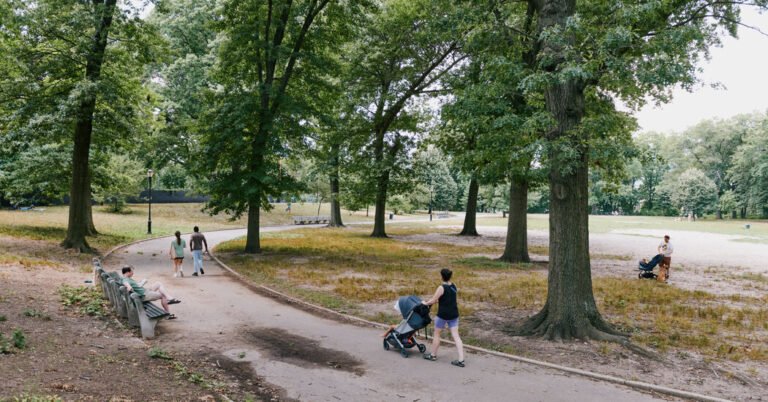
Oak trees with leaves like outstretched hands and thick, stately trunks reduce the effects of extreme heat around New York City’s five boroughs by shading sidewalks and sucking up planet-warming carbon.
These workhorses also naturally emit a chemical called isoprene. Alone, it is harmless. But when isoprene meets nitrogen oxides, a group of gasses emitted when fossil fuels are burned to power buildings and vehicles, the chemical reaction creates ground-level ozone, a harmful pollutant that can cause respiratory issues.
“The trees themselves don’t create any problems, in fact they solve a lot of problems for us in cities,” said Andrew Reinmann, associate professor of environmental science at the City University of New York and an author of a new study examining the isoprene emissions of city trees. “The problem is cars and fossil fuel combustion in cities that can essentially start to negate or take away some of the benefits that trees are providing us.”
The study, published in July in Environmental Science and Technology, looked at citywide data for every six-by-six-inch square of tree canopy across the five boroughs. The researchers analyzed the types of trees and modeled what could happen to ground-level ozone pollution if the city grew enough trees to cover 40 percent of its land.
In one scenario, if the city only planted oaks, ground-level ozone in Manhattan could increase more than 30 percent. In a second scenario, continuing to plant a mixed canopy like the one that exists today could increase peak ground-level ozone by about 10 percent, depending on the borough.
New York City repeatedly violates federal health-based air quality standards for ozone on hot days, according to the study. Every year more than 400 New Yorkers are estimated to die from ground-level ozone pollution, and more than 4,300 adults and children in the city visit emergency rooms for ozone-related asthma.
However, if nitrogen oxides emissions fell, either from switching to electric vehicles or from lowering fossil fuel use in buildings, ground-level ozone as a public health threat would be greatly reduced, regardless of what trees were planted where.
“Trees are providing so much, we really want to reduce the nitrogen oxides to make the most of them,” said Roisin Commane, an associate professor at Columbia University and another author of the study.
In 2017, tree canopy covered more than one-fifth of New York City, and a new city program called Urban Forest Agenda aims to expand the tree canopy to cover 30 percent of the city by 2035 through the growth of existing trees and the planting of new ones.
Reducing the reliance on gas-powered cars in the city, through programs like the congestion pricing plan halted by Gov. Kathy Hochul in June, could help to reduce emissions of nitrogen oxides. But the biggest source of New York City’s greenhouse gas emissions is the fossil fuels that heat and cool buildings, so changing fossil-powered emissions would be much more effective than changing the trees, the study authors said.
Trees provide a multitude of benefits like managing storm-water capture, protecting biodiversity and wildlife and providing social benefits like access to nature while making neighborhoods more beautiful and livable.
They also help reduce the urban heat island effect that causes cities to experience higher temperatures than surrounding areas because of the high concentration of buildings, roads, and rooftops that absorb and radiate the sun’s heat.
And it’s really hot days, increasing in the city under human-caused climate change, that create the reaction between nitrogen oxides and isoprene.
“We get much more ozone during a heat wave,” Dr. Commane said. Trees expire more isoprene the hotter it gets, culminating around 35 degrees Celsius. That’s about the same temperature at which so-called peaking units come online if the city isn’t producing enough electricity. Those generators are mostly powered by diesel and gas that emit nitrogen oxides when burned.
While the study recommends planting non- or low-isoprene emitting trees in places like New York City that have high concentrations of nitrogen oxides to avoid increasing ozone levels, other experts said that the conclusion failed to account for the pollutant, nitrogen oxides, and all the benefits big shade trees like oaks can bring.
“We don’t feel that one particular tree should really drive our species selection to either include or exclude a tree from the urban forest,” said Jennifer Greenfeld, deputy commissioner for environment and planning at the New York City Parks Department. “We don’t anticipate changing our planting palette based on the results of this study alone.”
The agency is responsible for planting and caring for 30,000 acres of land containing seven million trees. And in the last two decades, they’ve expanded their tree-selection variety from about 29 species to 130, Ms. Greenfeld said.
“To jump to a conclusion that would eliminate a foundational species or one that thrives in adverse conditions based purely on one attribute related to air quality is potentially short sighted,” said Sarah Charlop-Powers, executive director of the Natural Areas Conservancy, an environmental nonprofit group.
Dr. Reinmann said the study didn’t suggest removing oak trees or ending oak tree plantings. He said he worries about waking up one morning and seeing a headline that reads, “New York Shouldn’t Plant Trees Anymore.”